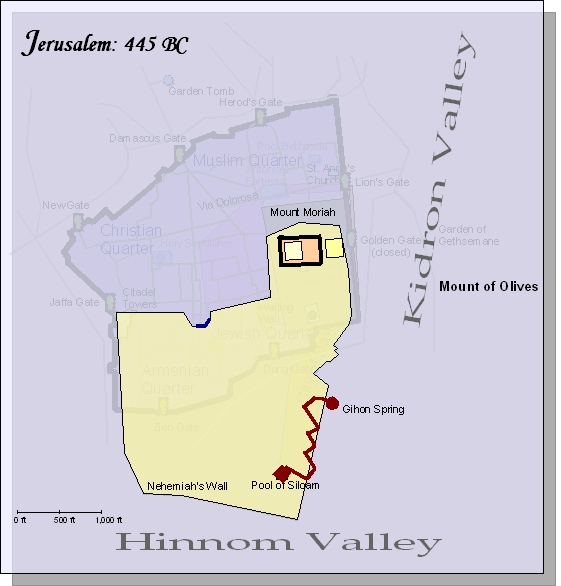Use these links to view a map of Jerusalem through the ages. Be sure to read the descriptions below the map.
Map 1 | Map 2 | Map 3 | Map 4 | Map 5 |

- In 966 BC, Solomon replaced the tabernacle with a temple of stone cut from the quarries of Timnah, about 130 miles south of Jerusalem. (1 Kings 6:1). All the stonework was done at the quarry so that the sound of metal and stone would not be heard at the temple site. Cedar was brought in from Lebanon. The temple was massive and ornate and took 6 years to build. Solomon’s palace, located just south of the temple, took 13 years to build (1 Kings 7:1)
- As the city population grew, the walls were extended to enclose the homes and buildings that were built outside the city wall.
- Because of their relentless idolatry, in 722 BC, King Sennacherib of Assyria attacked the northern 10 tribes of Israel, conquered them, and exiled them to slavery in Assyria. They never returned (1 Kings 17). The King of Assyria then attacked Jerusalem, but because Hezekiah was a righteous king, God allowed Jerusalem to prevail. In order to prepare for the war, King Hezekiah dispatched two teams to dig a tunnel through solid rock in order to bring water from the Gihon Spring (outside the city) into the Pool of Siloam (inside the city). The tunnel was completed in 701 BC (2 Kings 20:20)
- In 586 BC, because of their idolatry, Jerusalem fell to Nebuchadnezzar, king of Babylon, and its inhabitants were exiled to slavery in Babylon. The temple was destroyed, but rebuilt 70 years later by decree of Cyrus the Persian. Unlike the northern kingdom of Israel, the southern kingdom of Judah that had been exiled to Babylon was allowed to return to their homeland. (2 Chron 36:23).
This map depicts the wall of Jerusalem that Nehemiah rebuilt in 445 BC. Despite fierce opposition, he completed the wall in 53 days. The small section of the wall colored in blue still stands today. It can be seen on the Jerusalem page.
